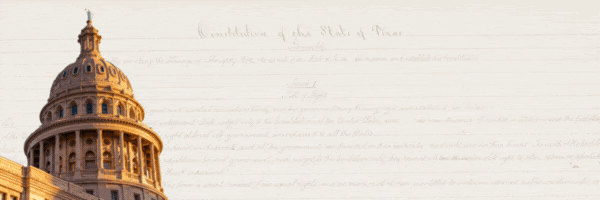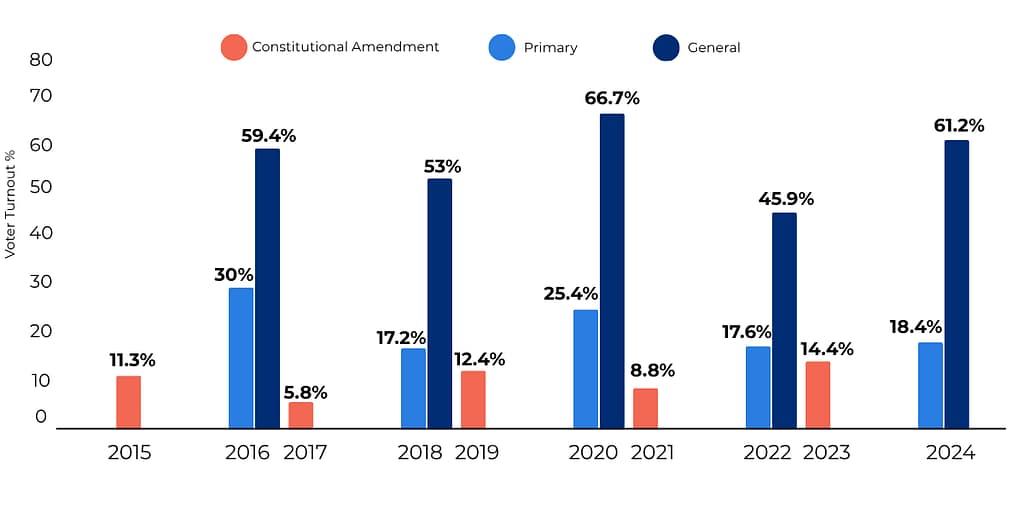Our Constitution and why Texans vote on constitutional changes
This is a preview of our Texas 2036 newsletter with our guide to our state’s constitution and the biennial process of making changes to it. To receive this weekly look at our work, sign up here.
A big election is coming up: What to know

Starting next week, Texans will make decisions that could shape our state for generations by voting on changes to the Texas Constitution.
These elections often fly under the radar, but they define how Texas governs itself. Here’s what you need to know and why your vote carries more weight than you might think.
But first… yes, Texas has a constitution.

The current Texas Constitution was written in 1876. Before that, Texas had five constitutions:
- 1836 – Constitution of the Republic of Texas
- 1845 – Adopted when Texas joined the United States as the 28th state
- 1861 – Adopted when Texas seceded from the Union and joined the Confederacy
- 1865 – Post-Civil War Constitution
- 1869 – Reconstruction Constitution
Our current Constitution, shaped by post-Civil War Reconstruction, limits the powers of the Legislature and Governor. Each amendment since then reflects how Texans have adapted to the challenges of their time.
Why do we amend the Texas Constitution?

While amendments to the U.S. Constitution are rare, they’ve become a biennial tradition in Texas.
Unlike the U.S. Constitution, which grants broad powers to the federal government, the Texas Constitution places strict limits on state authority. As a result, even minor issues often require constitutional amendments.
Voters have amended the Texas Constitution 530 times, compared to just 17 amendments to the U.S. Constitution since 1791, making Texas’ constitution the second-longest in the country behind Alabama.
Here are the proposed amendments this fall

There are 17 proposed amendments to the Texas Constitution that will be on the ballot this fall. Voters can review details on each proposition through the Texas Secretary of State’s website.
🗓️ Key dates for this year’s constitutional amendment election:
Early voting begins: Oct. 20
Early voting ends: Oct. 31
Election Day: Nov. 4
When Only a Few Million Vote
Only about 1.5 million to 2.5 million Texans typically participate in constitutional amendment elections, out of more than 18 million registered voters. Turnout for party primary and general elections tends to run much higher.
That means a small slice of voters often makes decisions that affect the entire state for decades to come.
Texas Voter Election Turnout, 2015-2024
 Source: Texas Secretary of State
Source: Texas Secretary of State
Who Shows Up to Vote?

Voters in constitutional amendment elections tend to be older and more affluent.
- A UH Hobby School survey ahead of the 2023 constitutional amendment election found that less than 25% of likely voters were under 42.
- 71% were homeowners, compared to 26% who were renters.
- In that election, a measure to increase the homestead exemption may have boosted homeowner turnout.
If trends hold, half of voters this November will be 65 or older.
💡 More info: Jordan Wat, our government affairs director, dives deeper into who turns out for constitutional amendment elections. Read more here.
Low Turnout Makes Your Vote Matter More

Every change to the Texas Constitution reflects the will of those who show up to vote.
In 2023, even with unusually high turnout, only one in seven registered voters helped approve 13 of 14 propositions. These decisions shaped property taxes, infrastructure and economic development for years to come.
The bottom line? Your vote matters more.
Want to learn more about the TX Constitution?
There’s still more to learn, and only so much we can pack in our newsletter. That’s why Texas 2036’s constitution expert, Luis Soberon, has broken up this knowledge for you.
